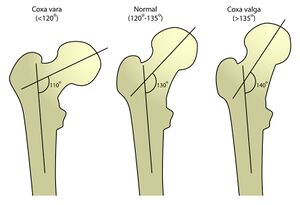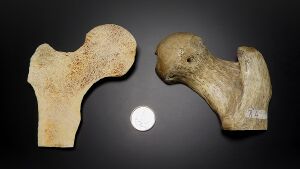Femoral Neck Fractures Biomechanics: Difference between revisions
No edit summary |
No edit summary |
||
| Line 2: | Line 2: | ||
== Introduction == | == Introduction == | ||
The hip joint contact forces are in excess of 500% body weight (BW) and can be as high as 509 kg of force during during ADL's, but spontaneous fractures typically do not occur in healthy individuals. Age, osteoporosis, or metastatic lesions, however, may weaken bone tissue to such an extent that spontaneous femoral neck fractures (NOF) do occur. In NOF fractures the loads exceed the strength. Not only is the amount of load important but also the direction of loading. These fractures occur: during vertical impact along the femoral shaft axis usually with a flexed hip; during sideways impact on the greater trochanter; or during torsional moments acting on the leg with an abducted hip., when loads are transferred to the hip joint. | |||
Fracture risk is determined by the bone strength and the applied load. The main predictor of bone strength is the bone mineral density at the femoral neck. The bone mineral density can indicate fracture risk and it can be obtained via dual x-ray absorptiometry.<ref name=":2">Augat P, Bliven E, Hackl S. [https://journals.lww.com/jorthotrauma/FullText/2019/01001/Biomechanics_of_Femoral_Neck_Fractures_and.6.aspx Biomechanics of femoral neck fractures and implications for fixation]. Journal of orthopaedic trauma. 2019 Jan 1;33:S27-32.</ref>Other factors that determine fracture risk are bone geometry, cortical bone thickness, and cortical bone density.<ref name=":2" /> The cortical bone matrix has a direct effect on the overall mechanical strength of the bone. Bone porosity, which can be assessed through a bone biopsy, is a strong predictor of mechanical strength.<ref name=":2" /> | Fracture risk is determined by the bone strength and the applied load. The main predictor of bone strength is the bone mineral density at the femoral neck. The bone mineral density can indicate fracture risk and it can be obtained via dual x-ray absorptiometry.<ref name=":2">Augat P, Bliven E, Hackl S. [https://journals.lww.com/jorthotrauma/FullText/2019/01001/Biomechanics_of_Femoral_Neck_Fractures_and.6.aspx Biomechanics of femoral neck fractures and implications for fixation]. Journal of orthopaedic trauma. 2019 Jan 1;33:S27-32.</ref>Other factors that determine fracture risk are bone geometry, cortical bone thickness, and cortical bone density.<ref name=":2" /> The cortical bone matrix has a direct effect on the overall mechanical strength of the bone. Bone porosity, which can be assessed through a bone biopsy, is a strong predictor of mechanical strength.<ref name=":2" /> | ||
| Line 29: | Line 29: | ||
* Category two is tensile type fractures that occur at the superior aspect of the bone. In normal conditions, the gluteus medius and minimus muscles counteract the high-tension forces acting on the femoral neck. However, tension femoral neck stress fracture occurs when the muscles are fatigued, and the tensile forces are translated predominantly by the bone.<ref name=":7" /> | * Category two is tensile type fractures that occur at the superior aspect of the bone. In normal conditions, the gluteus medius and minimus muscles counteract the high-tension forces acting on the femoral neck. However, tension femoral neck stress fracture occurs when the muscles are fatigued, and the tensile forces are translated predominantly by the bone.<ref name=":7" /> | ||
Sideway falls are a leading cause of [[Hip Fracture|hip fracture]] in the elderly population.<ref name=":0" /> Sideways falls, on the greater trochanter, induce a compressive type of load to the femoral neck.<ref name=":2" /> The factors that are involved in falls that contribute to fractures are femoral strength, fall velocity, and effective mass.<ref name=":0" /> Femoral strength is significantly reduced in a sideways fall scenario. The loading configuration determines the amount of force required to induce a fracture on the femoral neck. The force required to induce a fracture during a single leg stance is 7214N vs 3462N during a sideways fall ±1520N. The femoral neck can withstand a much greater force during vertical loading vs lateral loading on the greater trochanter.<ref name=":0" /> | Sideway falls are a leading cause of [[Hip Fracture|hip fracture]] in the elderly population.<ref name=":0">Nasiri Sarvi M, Luo Y. [https://link.springer.com/article/10.1007/s00198-017-4138-5 Sideways fall-induced impact force and its effect on hip fracture risk: a review]. Osteoporosis international. 2017 Oct;28(10):2759-80.</ref> Sideways falls, on the greater trochanter, induce a compressive type of load to the femoral neck.<ref name=":2" /> The factors that are involved in falls that contribute to fractures are femoral strength, fall velocity, and effective mass.<ref name=":0" /> Femoral strength is significantly reduced in a sideways fall scenario. The loading configuration determines the amount of force required to induce a fracture on the femoral neck. The force required to induce a fracture during a single leg stance is 7214N vs 3462N during a sideways fall ±1520N. The femoral neck can withstand a much greater force during vertical loading vs lateral loading on the greater trochanter.<ref name=":0" /> | ||
Fall velocities greater than 3m/s can induce a fracture on the femoral neck. Falls due to a slip or stumble have higher fall velocity than falls due to incorrect shifting of weight.<ref name=":0" /> The effective mass is the part of the body that moves downwards and creates the impact load. A fall from a standing position is going to have a larger effective mass than a fall from a kneeling position.<ref name=":0" /> | Fall velocities greater than 3m/s can induce a fracture on the femoral neck. Falls due to a slip or stumble have higher fall velocity than falls due to incorrect shifting of weight.<ref name=":0" /> The effective mass is the part of the body that moves downwards and creates the impact load. A fall from a standing position is going to have a larger effective mass than a fall from a kneeling position.<ref name=":0" /> | ||
Revision as of 02:08, 10 December 2022
Introduction[edit | edit source]
The hip joint contact forces are in excess of 500% body weight (BW) and can be as high as 509 kg of force during during ADL's, but spontaneous fractures typically do not occur in healthy individuals. Age, osteoporosis, or metastatic lesions, however, may weaken bone tissue to such an extent that spontaneous femoral neck fractures (NOF) do occur. In NOF fractures the loads exceed the strength. Not only is the amount of load important but also the direction of loading. These fractures occur: during vertical impact along the femoral shaft axis usually with a flexed hip; during sideways impact on the greater trochanter; or during torsional moments acting on the leg with an abducted hip., when loads are transferred to the hip joint.
Fracture risk is determined by the bone strength and the applied load. The main predictor of bone strength is the bone mineral density at the femoral neck. The bone mineral density can indicate fracture risk and it can be obtained via dual x-ray absorptiometry.[1]Other factors that determine fracture risk are bone geometry, cortical bone thickness, and cortical bone density.[1] The cortical bone matrix has a direct effect on the overall mechanical strength of the bone. Bone porosity, which can be assessed through a bone biopsy, is a strong predictor of mechanical strength.[1]
Geometrically, the normal femoral neck-shaft angle is between 124-135⁰. Femoral neck-shaft angle that is below 120⁰ is considered cox vara. If the femoral neck-shaft angle is above 135⁰ is considered coxa valga. Having a femoral neck-shaft angle that is outside of the normal range increases the risk of a femoral neck fracture.[2] Additionally, increased hip axis length (measured along the femoral neck axis and is defined as the distance from the inferolateral aspect of the greater trochanter to the inner pelvic brim), increased neck length, decreased cortical thickness, and decreased cross-sectional area of the femoral neck are all factors that can increase the risk of fracture.[1][2]
The initiation of fracture is typically at the superior aspect of the femoral neck, a region with less cortical thickness, and travels along through the trabecular bone.[3] The ageing process reduces bone mineral density and cortical bone thickness, which is why the prevalence of femoral neck fracture is higher in the elderly population.[3]
Biomechanics Involved[edit | edit source]
Forces[edit | edit source]
The femoral neck experiences the highest stress loads within the femur. [4] Forces that are acting on the femoral neck are externally, and internally generated forces.[1][3] Externally generated forces are a result of ground reaction forces that translated from the ankle to the femoral neck as a result of the vertical impact and typically stay below 1.3 times body weight during low-speed walking. [1] Internally generated forces are a result of the muscles acting on the bone to accomplish the desired movements and maintain balance. Internally generated forces are typically 2-3 times body weight during low-speed walking. [3]
The internal and external forces produce bending and torsional moments that act on the femoral neck. The bending moments at the femoral neck are a product of vertical loading during daily activities.[1] The bending moment creates compression on the inferior aspect of the femoral neck and tension at the superior aspect of the femoral neck.[1] The majority of the vertical loading force is transferred through vertically oriented trabeculae that are located at the inferior aspect of the femoral neck.[2]
The level of strain at the femoral neck is reported to be 500-2000 micro-strains for day-to-day activities.[1] The bone strain is largest at the inferior aspect of the neck. This results in a larger thickness of the bone cortex compared to the superior aspect.[1] The superior aspect of the femoral neck experiences increased strain during activities like stair climbing where there is an increase in hip flexion and abduction. The increased strain is due to the increase of torsion at the femoral neck.[3]
Femoral neck stress fractures occur when homeostatic remodelling can not keep up with the strain that is put on the bone. This is often due to repetitive loading of bone with abnormal forces and sudden increase in training volume or activity.[5] Femoral neck stress fractures are associated with activities like long-distance running, gymnastics, and ballet.[5] The cyclical loading of the tissue leads to decreased tissue tolerance. The micro-fractures that occur on the bone cannot be repaired fast enough and turn into fractures.[4]
Fracture Categories[edit | edit source]
Femoral neck stress fractures are subdivided into two categories:
- Category one is compressive type fractures that occur at the inferior aspect of the femoral neck. This type of fracture occurs when the forces applied to the bone are higher than the plastic properties of the bone.[5]
- Category two is tensile type fractures that occur at the superior aspect of the bone. In normal conditions, the gluteus medius and minimus muscles counteract the high-tension forces acting on the femoral neck. However, tension femoral neck stress fracture occurs when the muscles are fatigued, and the tensile forces are translated predominantly by the bone.[5]
Sideway falls are a leading cause of hip fracture in the elderly population.[6] Sideways falls, on the greater trochanter, induce a compressive type of load to the femoral neck.[1] The factors that are involved in falls that contribute to fractures are femoral strength, fall velocity, and effective mass.[6] Femoral strength is significantly reduced in a sideways fall scenario. The loading configuration determines the amount of force required to induce a fracture on the femoral neck. The force required to induce a fracture during a single leg stance is 7214N vs 3462N during a sideways fall ±1520N. The femoral neck can withstand a much greater force during vertical loading vs lateral loading on the greater trochanter.[6]
Fall velocities greater than 3m/s can induce a fracture on the femoral neck. Falls due to a slip or stumble have higher fall velocity than falls due to incorrect shifting of weight.[6] The effective mass is the part of the body that moves downwards and creates the impact load. A fall from a standing position is going to have a larger effective mass than a fall from a kneeling position.[6]
References[edit | edit source]
- ↑ 1.00 1.01 1.02 1.03 1.04 1.05 1.06 1.07 1.08 1.09 1.10 Augat P, Bliven E, Hackl S. Biomechanics of femoral neck fractures and implications for fixation. Journal of orthopaedic trauma. 2019 Jan 1;33:S27-32.
- ↑ 2.0 2.1 2.2 Kani KK, Porrino JA, Mulcahy H, Chew FS. Fragility fractures of the proximal femur: review and update for radiologists. Skeletal radiology. 2019 Jan;48(1):29-45.
- ↑ 3.0 3.1 3.2 3.3 3.4 Basso T, Klaksvik J, Syversen U, Foss OA. Biomechanical femoral neck fracture experiments—a narrative review. Injury. 2012 Oct 1;43(10):1633-9.
- ↑ 4.0 4.1 Neubauer T, Brand J, Lidder S, Krawany M. Stress fractures of the femoral neck in runners: a review. Research in Sports Medicine. 2016 Jul 2;24(3):283-97.
- ↑ 5.0 5.1 5.2 5.3 Robertson GA, Wood AM. Femoral neck stress fractures in sport: a current concepts review. Sports Medicine International Open. 2017 Feb;1(02):E58-68.
- ↑ 6.0 6.1 6.2 6.3 6.4 Nasiri Sarvi M, Luo Y. Sideways fall-induced impact force and its effect on hip fracture risk: a review. Osteoporosis international. 2017 Oct;28(10):2759-80.









